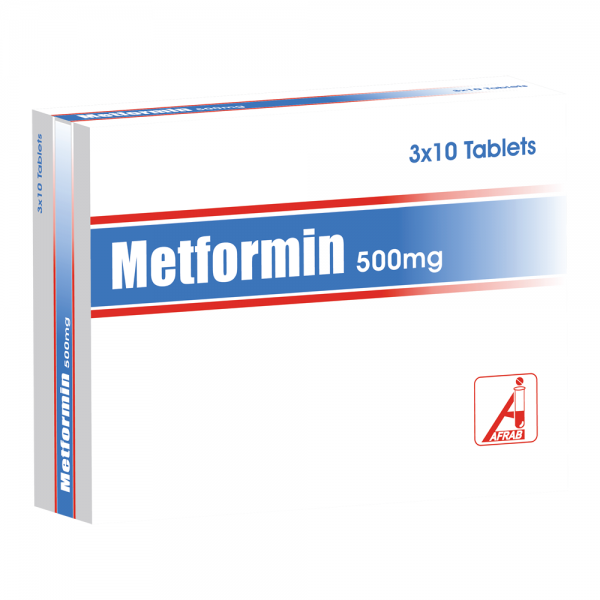- Have any questions?
- 0809 992 8864
- info@afrabchem.com
Products

Cystazole Suspension
March 1, 2019Detonic
March 5, 2019Metformin
Tablet (NRN: A4-7445): Metformin HCl 500 mg.
Pack size: Blister pack of 3 x 10.
Therapeutic Class
Antidiabetic, Biguanides
Dosage Form, Composition & NAFDAC Registration Number (NRN)
Tablet (NRN: A4-7445): Metformin HCl 500 mg.
Pack size: Blister pack of 3 x 10.
Pharmacology
Decreases blood glucose by decreasing hepatic glucose production.
May also decrease intestinal absorption of glucose and increase response to insulin.
Absorption:
Absolute bioavailability is approximately 50% to 60%. Tmax is 4 to 8 h; Cmax is approximately 0.6 to 1.8 mcg/mL (ER). Food decreases the extent of absorption and increases Tmax (immediate-release [IR]).
Distribution:
The apparent Vd is approximately 654 L; protein binding is negligible.
Elimination:
The major route for excretion is renal via tubular secretion as unchanged. The plasma elimination half-life is 6.2 h; the elimination half-life in blood is 17.6 h.
Indications
Metformin hydrochloride is a biguanide hypoglycaemic agent indicated in the treatment of non-insulin-dependent diabetes mellitus.
Contra-indications
- Known hypersensitivity to metformin hydrochloride or any of the product ingredient.
- Severe destabilization of diabetes.
- Renal and hepatic insufficiency.
- Infectious diseases.
- Disease which may cause tissue hypoxia.
- Persistent or severe diarrhea, recurrent vomiting.
Precautions/Warnings
Do not exceed the stated dose.
Do not use medicine after the “Expiry Date “on the pack.
Interactions
Inform your doctor or pharmacist if you are taking or have recently taken another drug, e.g. corticosteroids, nonsteroidal anti-inflammatory drugs, antihypertensive agents of the ACE-inhibitor class, beta-2 agonists (e.g. salbutamol, terbutaline), iodinated contrast media or medications containing alcohol, even if an over-the-counter medication is involved.
Adverse Effects
Gastrointestinal Reactions: Gastrointestinal symptoms (diarrhoea, nausea, vomiting, abdominal bloating, flatulence, and anorexia) are the most common reactions to Metformin Hydrochloride. These symptoms are generally transient and resolve spontaneously during continued treatment. Occasionally, temporary dose reduction may be useful. Because gastrointestinal symptoms during therapy initiation appear to be dose-related, they may be decreased by gradual dose escalation and by having patients take Metformin HCl with meals.
Because significant diarrhea and / or vomiting may cause dehydration and prerenal azotemia, under such circumstances, Metformin hydrochloride should be temporarily discontinued.
For patients who have been stabilised on Metformin hydrochloride, nonspecific gastrointestinal symptoms should not be attributed to therapy unless intercurrent illness or lactic acidosis have been excluded.
Special senses: During initiation of Metformin HCl therapy, approximately 3% of patients may complain of an unpleasant or metallic taste, which usually resolves spontaneously.
Dermatologic Reactions: The incidence of rash / dermatitis in controlled clinical trials was comparable to placebo for Metformin HCl monotherapy and to sulfonylurea for Metformin HCl / sulfonylurea therapy.
Lactic acidosis: Lactic acidosis is a rare, but serious, metabolic complication that can occur with Metformin; when it occurs, it is fatal in approximately 50% of cases. Lactic acidosis is a medical emergency and must be treated in a hospital.
Dosage & Administration
Metformin hydrochloride is given by mouth at an initial dosage of 250 mg two to three times daily with or after meals, gradually increased as needed to a maximum of 2.5 g daily.
Storage/Handling Recommendations
Keep medicine in a cool dry place and away from the reach of children.


Reviews
There are no reviews yet.